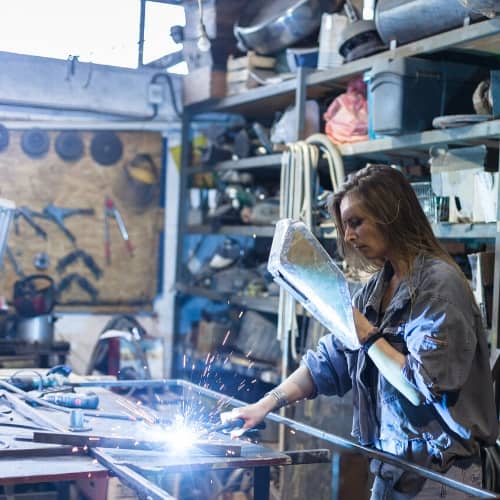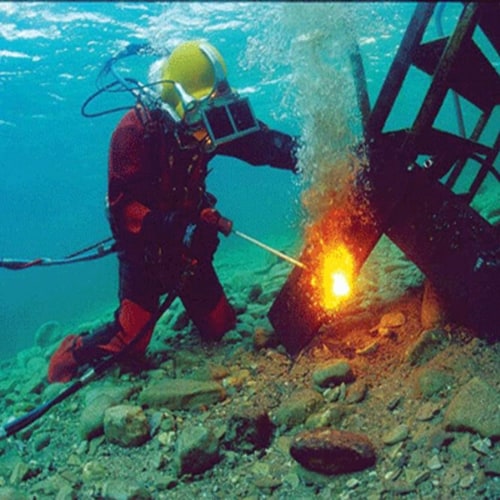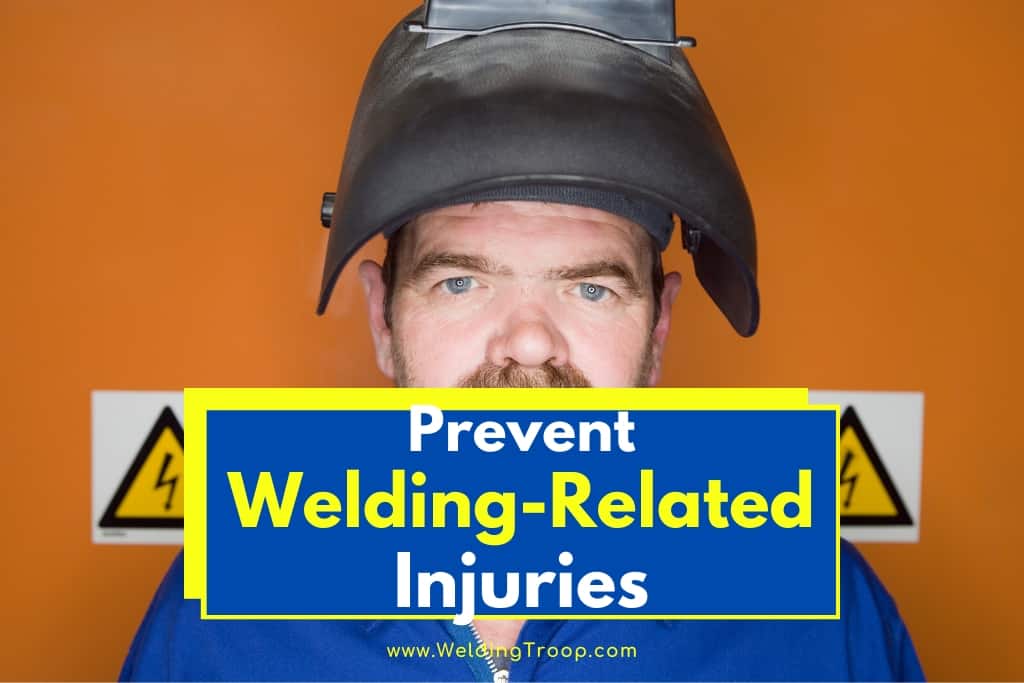Have you ever wondered what welding safety precautions to take? Well, we got you covered.
Welding can be a hazardous profession, but if you know seven easy steps to prevent welding-related injuries, you can safely weld in any environment. Understanding and following safety procedures are essential to enjoying a lasting career in welding.
Here are 7 easy welding safety precautions:
- Maintain a Clean Workspace
- Wear Protective Gear
- Maintain functioning welding equipment
- Work in a ventilated area
- Avoid extreme weather conditions
- Study the metals you weld
- Take additional precautions in hazardous environments
Welding is an exciting career, but if you fail to follow safety guidelines, your work may be cut short. Although the temperature ranges vary depending on the welding process, all welding uses high temperatures to fuse metal.
If you’re careless when you weld, you risk starting a fire or explosion that can injure or kill your coworkers or yourself.
Welding Safety Precautions
Protecting yourself and the people around you is crucial to becoming a prosperous and respected welder. If you follow and promote a few simple steps concerning welder safety, you’re unlikely to experience many work-related injuries
1. Maintain a Clean Workspace
Since you’re working with equipment that emits intense heat and radiation, it’s important to maintain a worksite that is free of clutter. Whether you’re in the shop or repairing a fence located next to an aging propane tank, your workspace should only contain the materials you need for the job.
In most welding shops, welders perform other tasks besides welding. These tasks include grinding, sanding, painting, brazing, and soldering.

Leftover metal flakes from a prior grinding project can interfere with and agitate your weld pool. Clean all metal dust and debris from your work area to ensure your site is contaminate-free.
Remove all flammable and combustible material before you begin welding. Oily rags or tools, gas tanks, air compressors, butane lighters, baseball hats, and chemical solvents should be stored away from your workspace.
Most accidental fires and explosions in the shop occur when nearby materials ignite from sparks or spatter.
2. Wear Protective Gear
Your personal protective equipment is your first line of defense against UV radiation, spatter droplets, sparks, and intense glare. Most burns and serious injuries can be avoided if you protect yourself.
Before you continue reading, here is an article we wrote about Personal Protective Equipment for Welders – PPE | List, and Requirements
Gloves
Purchase a few pairs of fire-resistant gloves so that you always have a backup pair. If you frequently stick weld, your gloves will not last as long as you would hope. Since you have to grip and manipulate the electrode with your hand, stick welding wreaks havoc on a welder’s gloves.
Welder’s Helmet
A helmet protects the welder from glare, UV radiation, sparks, and spatter. It is the most crucial component of your safety gear. The bright light can temporarily blind or permanently damage a welder’s eyes. Buy a premium welder’s helmet that auto-darkens and is rated for low temperatures.
Apron
A heavy, fire-resistant apron protects you from molten spatter. Spatter can quickly ignite cotton and polyester clothing but will only singe a welder’s apron.
Respirator
A premium respirator will protect your eyes and lungs from the toxic fumes emitted from the welding process.
Some metals, like galvanized steel, produce poisonous fumes when you weld them.
The lead and zinc fumes can seriously damage your lungs from prolonged exposure and result in galvanize poisoning.
Related reading: Why Is Welding Galvanized Steel Dangerous?
3. Maintain Functioning Equipment
Your welding machine and its components experience a lot of abuse during an average workday. To avoid an accidental fire or electrocution, inspect your equipment before you weld. A blown fuse or frayed wire should be repaired before you attempt to weld.
If you’re qualified to make minor repairs or adjustments, remember to unplug your welding machine. Turning the welder off will not protect you from an electrical surge. However, only a professional electrician or specialist should make significant repairs on a welding machine.
Replace your MIG nozzles frequently and try to use a fresh electrode for lengthy stick welding projects. A stubby electrode is harder to manipulate and more hazardous to use.
4. Work in a Ventilated Area
The ideal location for welding is outdoors. The fumes from consumable metals will not affect you as much if you’re able to weld outside. However, you cannot take every welding project outside. The best alternative is a well-ventilated room.
Some welding shops have large hood systems that provide adequate ventilation for large projects. The systems are similar to those used in restaurant kitchens and are necessary for cramped shops that lack windows.
The hood draws in smoke and toxic smoke, and then, vents the contaminates through an outlet on the roof or side of the building. If your shop does not feature a hood system or open windows, you can set up a series of fume extractors at each workstation.
Place each extractor a few feet from the welding area and ensure it is not close enough to the weld zone to become damaged from spatter.
5. Avoid Extreme Weather Conditions
The weather often ruins the plans of outdoor workers who must remain inside during a storm. Heavy rain is a concern when you work with a welder that requires an electrical current to function.
In light rain, you can use a welding tent to shelter your work. If you’re able to keep your equipment dry, you can safely weld, but under no circumstances, attempt to weld under heavy rain or a thunderstorm.
Tents keep the falling rain from interfering with your work, but no shelter can contain the rain collecting on the ground level.
Heavy rain causes flash floods and surface pooling. Pooling water can short out your welder, or at the worst, it can electrocute you.
In windy conditions, you can use welding blankets or tents as windbreaks. If you’re unable to shield your arc welder from winds over 35 mph, you will have to weld another day. An electric arc cannot maintain an efficient weld pool with winds over 35 mph.
Related reading: Is it Safe to Weld in the Wind? Maximum Wind Velocity
6. Study the Metals You Weld
Some welders are surprised when they weld an unfamiliar metal that creates a violent, unpredictable weld pool. Each type and thickness of metal reacts differently to welding. Some metals, like carbon steel, are not particularly challenging to weld and are often perfect for training newcomers.
Other metals, such as aluminum, manganese, or galvanized steel, require more preparation and skill to successfully weld. Both metals contain a surface coating that you must remove before you weld. If you’re unaware of the unique properties of the metals you work with, you’ll waste a lot of time and possibly risk bodily harm.
Study the information on each metal and piece of equipment you frequently use. It’s important to know which electrodes work with AC or DC and which nozzles are suitable for high amperage jobs.
All manufacturers of welding machines, electrodes, and safety equipment include essential information on how to use their products safely. Read all specifications sheets and manuals to stay up to date on any new safety information.
Related reading: How Many Amps Do I Really Need for a MIG Welder?
7. Take Additional Precautions in Hazardous Environments
Staying safe while you weld is not difficult when you follow safety procedures, but when you work in hazardous environments, you have to take extra precautions.
High elevation welding such as skyscraper or bridge construction compels an experienced welder to focus as much on the environment as the job.
At higher elevations, the wind is more intense. Safety harnesses and windbreaks are necessary when the wind is strong enough to move your tools around.
In frigid conditions, amateurs sometimes forget to wear fire-resistant clothing over their heavy coats. It’s tempting to believe that an expensive artic coat will protect you against spatter, but molten metal will instantly burn through any material that is not fire-resistant.
No matter how uncomfortable it is, always wear protective gear. Whether it is -20° F or 105° F, you should always protect yourself from glare, radiation, and spatter.
If you’re anxious to work in the most dangerous form of welding, you’ll have to become an expert welder and scuba-diver. Underwater welding requires the highest level of competence, concentration, and safety awareness.

From seven to ten welders die each year from underwater welding, and unless you want to become a statistic, you’ll have to train hard for several years before you can weld underwater.
Related reading: 7 Steps for Avoiding Electric Shock When Welding Underwater
Closing Remarks
As part of the construction industry, welding is considered one of the most hazardous professions in the world. Protecting yourself from radiation, blinding glare, and molten metal is part of your average day. As long as you follow the steps to preventing welding injuries, you’ll have a long, prosperous career in welding.

